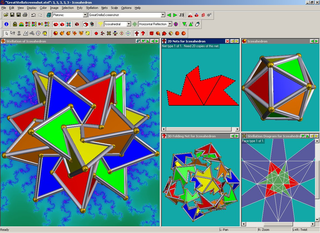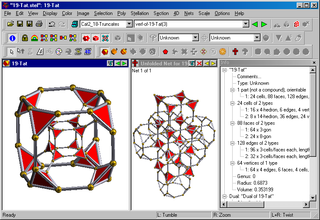| This article includes a list of references, related reading, or external links, but its sources remain unclear because it lacks inline citations. Please help improve this article by introducing more precise citations. (March 2012) (Learn how and when to remove this message) |


Stella is a computer program available in three versions (Great Stella, Small Stella and Stella4D). It was created by Robert Webb of Australia. The programs contain a large library of polyhedra which can be manipulated and altered in various ways.
Polyhedra
Polyhedra in Great Stella's library include the Platonic solids, the Archimedean solids, the Kepler-Poinsot solids, the Johnson solids, some Johnson Solid near-misses, numerous compounds including the uniform polyhedra, and other polyhedra. Operations which can be performed on these polyhedra include stellation, faceting, augmentation, dualization (also called "reciprocation"), creating convex hulls, and others.
All versions of the program enable users to print nets for polyhedra. These nets may then be assembled into actual three-dimensional polyhedral models of great beauty and complexity.
Stella4D
In 2007, a Stella4D version was added, allowing the generation and display of four-dimensional polytopes (polychora), including a library of all convex uniform polychora, and all currently known nonconvex star polychora, as well as the uniform duals. They can be selected from a library or generated from user created polyhedral vertex figure files.
Features
Stella provides a configurable workspace comprising several panels. Once a model has been selected from the range available, different views of it may be displayed in each panel. These views can also include measurements, symmetries and unfolded nets.
A variety of operations may be performed on any polyhedron. In 3D these include: stellation, faceting, augmentation, excavation, drilling and dualising.
Other features include spring network relaxation, generation of the convex hull, and generation of cupolaic blends and related figures.
Release history
- v1.0 – 20 August 2001 – First release of Stella
- v1.1 – 14 January 2002
- v2.0 – 12 September 2002
- v2.8.7 – 16 November 2004
- v3.0 – 12 June 2005
- v3.5.1 – 10 May 2006
- v4.0 – 13 March 2007 – (Including new "Stella4D")
- v4.4 – 11 January 2008
- v5.0 – 30 September 2012
- v5.4 – 10 May 2014
References
- Bedford, Mike (August 2008). "Great Stella software". PC Plus. No. 271. pp. 46–47.
This is quite a sophisticated program for those who want to go beyond the basics.
- Ms. Megabyte (4 February 2003). Ms Megabyte presented Stella. Today.
- Webb, Robert (2000). "Stella: Polyhedron Navigator". Symmetry: Culture and Science. 11 (1–4): 231–268. Zbl 1026.52010. (Note: journal was back-dated. Paper actually written 2003)
Further reading
- Webb, Robert (2002). "Stella Models". Symmetry: Culture and Science. Vol. 13, no. 3–4. pp. 391–399. (Note: journal was back-dated. Paper actually written 2004)